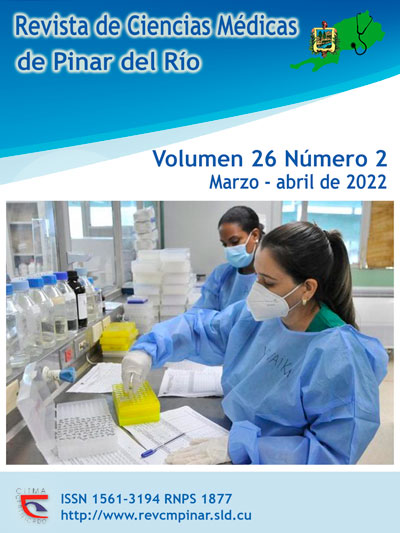Climate change and biosafety in times of COVID-19
Keywords:
CLIMATE CHANGE, CONTAINMENT OF BIOHAZARDS, ENVIRONMENT, COVID-19, PANDEMICS.Abstract
Introduction: climate change is an undeniable reality, with an effect on human beings and healthcare services. Biosafety is a valuable weapon to face the challenges set out to the healthcare services by climate change.
Objective: to describe the relationships among human beings, climate change and biosafety.
Development: for years, the effects of climate change on human beings have been warned. Since then, institutions were created in Cuba for the rational use and exploitation of natural resources, as well as for the development of measures to mitigate the effects of climate change. The modifications in the dynamics of the environment, the habitats of the living beings, desertification and drought cause variations in the patterns of behavior of diseases, causing reemergence of some eradicated ones, mutations and new strains of others, turning them into a latent danger for the species. The accomplishment of institutional biosafety and social measures to manage COVID-19 has shown efficiency.
Conclusions: the compliance of biosafety norms in healthcare institutions has a synergic effect along with Life Task (Tarea Vida), through the control of biological risk. Biosafety standards allow facing the changes in ecosystems and preserving human health, much more in times of COVID-19 pandemic.
Downloads
References
1. Dickinson MFO. Retos del cambio climático para la Salud Pública en Cuba. Rev Cubana Hig Epidemiol [Internet]. 2017 [citado 21/03/2020]; 55: (2):1-3. Disponible en: https://www.medigraphic.com/cgi-bin/new/resumen.cgi?IDARTICULO=87028
2. República de Cuba, Consejo de Ministros. Tarea Vida. Plan de Estado para el enfrentamiento al cambio climático. La Habana: Ministerio de Ciencia, Tecnología y Medio Ambiente; 2017. http://repositorio.geotech.cu/jspui/bitstream/1234/2864/1/Plan%20de%20Estado%20para%20el%20Enfrentamiento%20al%20Cambio%20Clim%C3%A1tico%20en%20la%20Rep%C3%BAblica%20de%20Cuba%20(Tarea%20Vida).pdf.
3. Castro Ruz F. Discurso pronunciado en Rio de Janeiro en la Conferencia de Naciones Unidas sobre Medio Ambiente y desarrollo 12-6-1992.Disponible en: http://www.fidelcastro.cu/es/discursos/discurso-en-la-conferencia-de-naciones-unidas-sobre-medio-ambiente-y-desarrollo-rio-de
4. Cuadros Cagua TA. El cambio climático y sus implicaciones en la salud humana. Ambiente y Desarrollo [Internet]. 2017 [citado 21/03/2020]; 21: (40):157-171. Disponible en: https://doi.org/10.11144/Javeriana.ayd21-40.ccis
5. Guevara A, Paz L. República de Cuba. Segunda comunicación nacional a la Convención Marco de las Naciones Unidas sobre Cambio Climático. La Habana: Ministerio de Ciencia Tecnología y Medio Ambiente; 2015. Acceso el 20 de marzo de 2020.
Disponible en: http://unfccc.int/essential_background/library/items/3599.php?rec=j&priref=7803#beg
6. República de Cuba, Consejo de Defensa Nacional. Directiva N.° 1 del Presidente del Consejo de Defensa Nacional para la planificación, organización y preparación del país para las situaciones de desastres. La Habana: CDN; 2010. Acceso el 30 de marzo de 2020. Disponible en:
http://www.sld.cu/galerias/pdf/sitios/desastres/directiva_vp_cdn_sobre_desastres.ultima_version.pdf
7. Mesa Ridel G, González García J, Reyes Fernández MC, Cintra Cala D, Ferreiro Rodríguez Y, Betancourt Lavastida JE. El sector de la salud frente a los desastres y el cambio climático en Cuba. Rev Panam Salud Pública. [Internet]. 2018 [citada 21/03/2020] ; 42: (24) Disponible en: https://doi.org/10.26633/RPSP.2018.24
8. Toledo García ME, Apodaca Pérez EC, Reyes Roig GM. La gestión del mantenimiento para lograr instituciones de salud seguras e inteligentes. La Habana. Convención Internacional de Salud, Cuba Salud 2018. Acceso el 30 de marzo de 2020. Disponible en: http://www.convencionsalud2018.sld.cu/index.php/connvencionsalud/2018/paper/viewFile/191/44
9. Pérez Villavicencio JJ, Franco Enríquez JG. Nocividad del proceso de trabajo en un hospital público de la ciudad de México. Salud trab. (Maracay) [Internet]. 2015 [citado 21/03/2020];23(1):39-48. Disponible en: http://ve.scielo.org/pdf/st/v23n1/art04.pdf
10. Loro Marli M, Zeitoune Regina CG. Estrategia colectiva de enfrentamiento de los riesgos ocupacionales del equipo de enfermería. Rev. esc. enferm. USP [Internet]. 2017 [cited 21/03/2020] ; 51: e03205. Available from: http://www.scielo.br/scielo.php?script=sci_arttext&pid=S0080-62342017000100402&lng=en.
11. Verdera Hernández J, Bermúdez Pérez R. Bioseguridad Básica. La Habana: Ed. Ciencias Médicas, 2011.
12. Vera Núñez D, Castellanos Sánchez E, Rodríguez Díaz PH, Mederos Escobar TT. Efectividad de Guía de Buenas Prácticas en la bioseguridad hospitalaria. Rev Cubana Enfermer [Internet]. 2017 Mar [citado 21/03/2020]; 33(1): 40-51. Disponible en: http://scielo.sld.cu/scielo.php?script=sci_arttext&pid=S0864-03192017000100006&lng=es.
13. Bravo Martín SF, Díaz Morales D. Riesgo biológico en Instituciones de salud: control y precauciones en la atención a pacientes. Medicentro Electrónica [Internet]. 2016 Jun [citado 21/03/2020]; 20(2): 153-155. Disponible en: http://scielo.sld.cu/scielo.php?script=sci_arttext&pid=S1029-30432016000200012&lng=es.
14. Contreras ZR, Ramírez P, Bermúdez V. Asociación entre la exposición al riesgo biológico y signos y síntomas clínicos en asistentes de laboratorio. AVFT [Internet]. 2017 Jun [citado 21/03/2020]; 36(3): 49-57. Disponible en: http://ve.scielo.org/scielo.php?script=sci_arttext&pid=S0798-02642017000300001&lng=es.
15. Martínez Calvo S. Comentarios acerca de la percepción de riesgo en la población cubana. Rev Cubana Salud Pública [Internet]. 2018 Jun [citado 21/03/2020]; 44(2): 426-430. Disponible en: http://scielo.sld.cu/scielo.php?script=sci_arttext&pid=S0864-34662018000200426&lng=es.
16. Cobos Valdés D, Vilariño Corella CM, Vázquez Mojena Y, Ramos Lima M, Torres Valle A. Percepción del riesgo biológico en dos entidades de ciencia del sector salud en Holguín: Cuba. Med. segur. trab. [Internet]. 2016 Sep [citado 21/03/2020]; 62(244): 212-222. Disponible en: http://scielo.isciii.es/scielo.php?script=sci_arttext&pid=S0465-546X2016000300005&lng=es.
17. Iglesias-Osores S, Saavedra-Camacho JL. Riesgo de contagio por SARS-CoV-2 en estomatólogos. Univ Méd Pinareña [Internet]. 2020 [citado 20/07/2020]; 16(2): e496. Disponible en: http://www.revgaleno.sld.cu/index.php/ump/article/view/496
Downloads
Published
How to Cite
Issue
Section
License
Authors who have publications with this journal agree to the following terms: Authors will retain their copyrights and grant the journal the right of first publication of their work, which will be publication of their work, which will be simultaneously subject to the Creative Commons Attribution License (CC-BY-NC 4.0) that allows third parties to share the work as long as its author and first publication in this journal are indicated.
Authors may adopt other non-exclusive license agreements for distribution of the published version of the work (e.g.: deposit it in an institutional telematic archive or publish it in a volume). Likewise, and according to the recommendations of the Medical Sciences Editorial (ECIMED), authors must declare in each article their contribution according to the CRediT taxonomy (contributor roles). This taxonomy includes 14 roles, which can be used to represent the tasks typically performed by contributors in scientific academic production. It should be consulted in monograph) whenever initial publication in this journal is indicated. Authors are allowed and encouraged to disseminate their work through the Internet (e.g., in institutional telematic archives or on their web page) before and during the submission process, which may produce interesting exchanges and increase citations of the published work. (See The effect of open access). https://casrai.org/credit/



